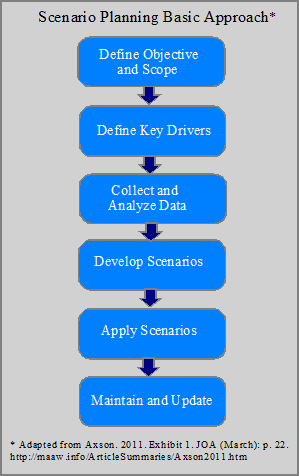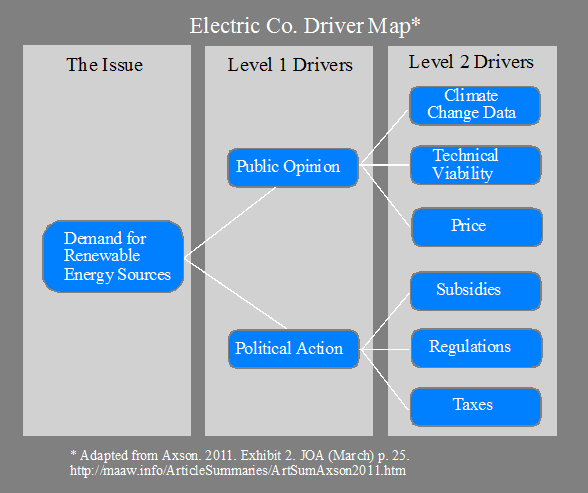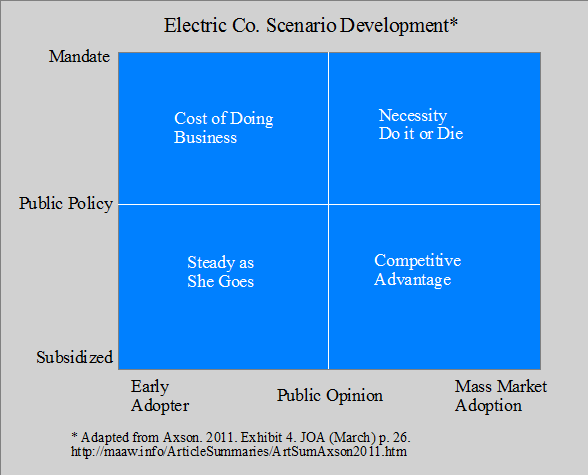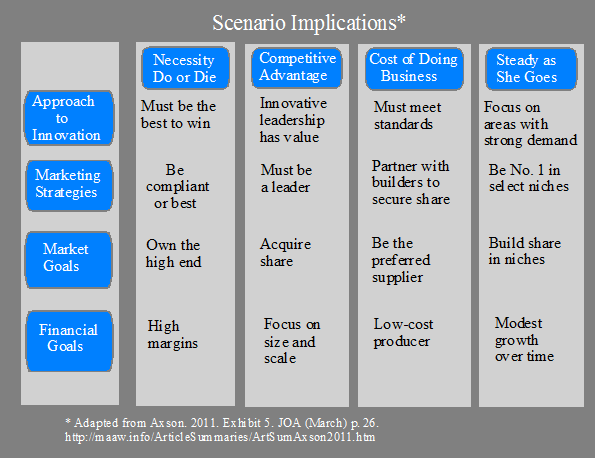
Summary by James R. Martin, Ph.D., CMA
Professor Emeritus, University of South Florida
Change and Risk Management Main
Page | Strategy Main Page
The world is a complex web of connected relationships where local events can have global impacts almost instantaneously (e.g, 9/11, European debt crisis, BP oil spill, the rapid growth of China and India). Scenario planning is a tool to aid management in this environment of uncertain and voltile markets. It provides a way to understand the forces that will shape the future such as, globalization, technological change, demographics, and environmental sustainability. The purpose of this paper is to describe scenario planning, discuss how accountants can get involved, and provide a case study to illustrate how the technique works in practice.
Building Scenario Plans
Scenario planning focuses on three questions: What could happen? What would the impact be on the organization's strategices, plans and budgets? How should the organization respond? There are four broad types of scenarios that include: social, economic, political, and technological. The first step is to define the issues or decisions the scenario project is trying to evaluate, and to determine if there is a high degree of uncertainty involved. If the answer is yes, then scenario planing may be an effective tool. The basic approach to scenario planning is illustrated in the graphic below along with a short description of each step.

Scenario Planning Basic Approach
Defining objective and scope - This step includes identifying the issues, decisions, key variables involved, scope of the study, time horizon and approach selected and agree on by senior management. The project team should develop a project charter that includes all this information.
Define key drivers - This step includes identifying the key internal and external drivers involved in the study and the critical relationships between them.
Collect and analyze data - This includes collecting quantitative and qualitative data as well as expert opinion, and the analysis of the data to determine the impact and predictability of the drivers identified in step two. It also includes defining appropriate measures for the key drivers.
Develop scenarios - Develop scenarios with narrative descriptions, test them using the data collected, update and develop evaluation criteria for related strategies and plans.
Apply scenarios - Test the sensitivity of strategies and plans for each scenario, formulate contingency plans and mitigation stratgies, and communicate the results to all constituencies.
Maintain and update - Integrate the leading indicators and key performance measures, update the data and scenarios as needed over time.
Role of Accounting and Finance Professionals in Scenario Planning
Accounting and finance professionals can get involved in scenario planning by analyzing the financial implications of each scenario and the alternative strategies and contingency plans. They can also test the sensitivity of assumptions, develop alternative financial plans under the various scenarios, help define key performance measurements, and monitor and report on internal and external indicators that might influence the strategies.
Scenario Planning Case Study
The case study involves an electric company that wants to develop a better understanding of how environmental issues will affect the company, as well as the emerging markets for a smart grid, the risk profile of each market and the ease of market access. These issues become the objective of the study. The key drivers involved are determined to be public opinion, and political action. These first level drivers include second level drivers as illustrated in the graphic below.

The data collected includes information about economic growth, estimates of construction activity, fuel prices, GDP, climate change, demographics, technical feasibility, government regulations, taxes, and subsidies, and competitors' actions. Using this information the project team developed four scenarios as illustrated in the graphic below. The key drivers, i.e., public policy and public opinion are placed on the vertical and horizontal axes. Actions related to public policy range from mandate to subsidized, while public opinion ranges from early adopter to mass market adoption. The four scenarios include necessity (where non-green solutions are shunned by the market), market driven (green is a source of competitive advantage), mandate (green is a required cost of dong business), and steady as she goes (high prices for early adopters before market flattens).

Various strategies are developed for each scenario in terms of the organization's approach to innovation, marketing strategy, market goals, and financial goals. These possible strategies are provided in the illustration below labeled Scenario Implications.

Using the implications for the four scenarios, the project team recast the company's budget and five year plan under each scenario showing financial implications and performance measurements that were tracked to the company's balanced scorecard. This was followed by what-if analysis and a constant review comparing actual and forecasted results against the scenarios.
_________________________________________________
Summaries related to Enterprise Risk Management:
COSO. 2016. Enterprise Risk Management: Aligning Risk with Strategy and Performance. Public Exposure Draft. (June). (Summary).
Kaplan, R. S. and A. Mikes. 2012. Managing risks: A new framework. Smart companies match their approach to the nature of the threats they face. Harvard Business Review (June): 48-60. (Summary).
Malone, D. and M. Mouritsen. 2014. Change management: Risk, transition, and strategy. Cost Management (May/June): 6-13. (Summary).
McKay, S. 2016. CGMA tools: How to communicate risks using a heat map. Journal of Accountancy (June): 35-40. (Summary).
Merchant, K. A. 2012. ERM: Where to go from here. Journal of Accountancy (September): 32-34, 36. (Summary).
Rice, C. and A. Zegart. 2018. Managing 21st-century political risk: Today's threats are more complicated, but the remedies don't have to be. Harvard Business Review (May/June): 130-138. (Summary).
Shenkir, W. G. and P. L. Walker. 2006. Enterprise risk management and the strategy-risk-focused organization. Cost Management (May/June): 32-38. (Summary).
Other related summaries:
Kaplan, R. S. and D. P. Norton. 1996. The Balanced Scorecard: Translating Strategy into Action Boston: Harvard Business School Press. (Summary).
Kaplan, R. S. and D. P. Norton. 2001. The Strategy-Focused Organization: How Balanced Scorecard Companies Thrive in the New Business Environment. Harvard Business School Press. (Summary).
Porter, M. E. 1980. Competitive Strategy: Techniques for Analyzing Industries and Competitors. The Free Press. (Summary).
Porter, M. E. 1996. What is a strategy? Harvard Business Review (November-December): 61-78. (Summary).